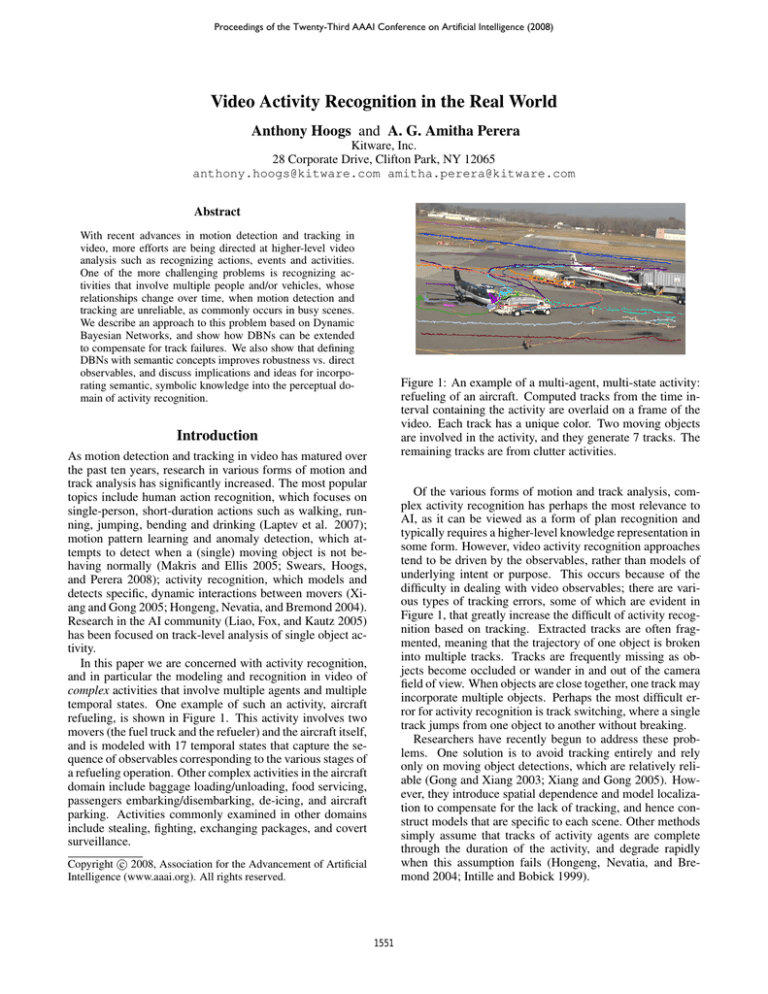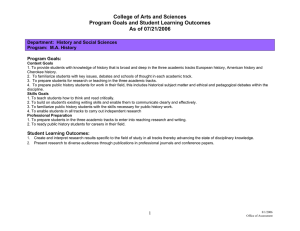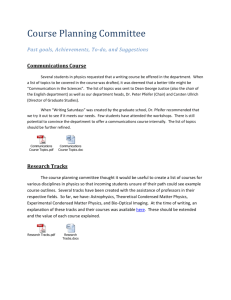
Proceedings of the Twenty-Third AAAI Conference on Artificial Intelligence (2008)
Video Activity Recognition in the Real World
Anthony Hoogs and A. G. Amitha Perera
Kitware, Inc.
28 Corporate Drive, Clifton Park, NY 12065
anthony.hoogs@kitware.com amitha.perera@kitware.com
Abstract
With recent advances in motion detection and tracking in
video, more efforts are being directed at higher-level video
analysis such as recognizing actions, events and activities.
One of the more challenging problems is recognizing activities that involve multiple people and/or vehicles, whose
relationships change over time, when motion detection and
tracking are unreliable, as commonly occurs in busy scenes.
We describe an approach to this problem based on Dynamic
Bayesian Networks, and show how DBNs can be extended
to compensate for track failures. We also show that defining
DBNs with semantic concepts improves robustness vs. direct
observables, and discuss implications and ideas for incorporating semantic, symbolic knowledge into the perceptual domain of activity recognition.
Figure 1: An example of a multi-agent, multi-state activity:
refueling of an aircraft. Computed tracks from the time interval containing the activity are overlaid on a frame of the
video. Each track has a unique color. Two moving objects
are involved in the activity, and they generate 7 tracks. The
remaining tracks are from clutter activities.
Introduction
As motion detection and tracking in video has matured over
the past ten years, research in various forms of motion and
track analysis has significantly increased. The most popular
topics include human action recognition, which focuses on
single-person, short-duration actions such as walking, running, jumping, bending and drinking (Laptev et al. 2007);
motion pattern learning and anomaly detection, which attempts to detect when a (single) moving object is not behaving normally (Makris and Ellis 2005; Swears, Hoogs,
and Perera 2008); activity recognition, which models and
detects specific, dynamic interactions between movers (Xiang and Gong 2005; Hongeng, Nevatia, and Bremond 2004).
Research in the AI community (Liao, Fox, and Kautz 2005)
has been focused on track-level analysis of single object activity.
In this paper we are concerned with activity recognition,
and in particular the modeling and recognition in video of
complex activities that involve multiple agents and multiple
temporal states. One example of such an activity, aircraft
refueling, is shown in Figure 1. This activity involves two
movers (the fuel truck and the refueler) and the aircraft itself,
and is modeled with 17 temporal states that capture the sequence of observables corresponding to the various stages of
a refueling operation. Other complex activities in the aircraft
domain include baggage loading/unloading, food servicing,
passengers embarking/disembarking, de-icing, and aircraft
parking. Activities commonly examined in other domains
include stealing, fighting, exchanging packages, and covert
surveillance.
Of the various forms of motion and track analysis, complex activity recognition has perhaps the most relevance to
AI, as it can be viewed as a form of plan recognition and
typically requires a higher-level knowledge representation in
some form. However, video activity recognition approaches
tend to be driven by the observables, rather than models of
underlying intent or purpose. This occurs because of the
difficulty in dealing with video observables; there are various types of tracking errors, some of which are evident in
Figure 1, that greatly increase the difficult of activity recognition based on tracking. Extracted tracks are often fragmented, meaning that the trajectory of one object is broken
into multiple tracks. Tracks are frequently missing as objects become occluded or wander in and out of the camera
field of view. When objects are close together, one track may
incorporate multiple objects. Perhaps the most difficult error for activity recognition is track switching, where a single
track jumps from one object to another without breaking.
Researchers have recently begun to address these problems. One solution is to avoid tracking entirely and rely
only on moving object detections, which are relatively reliable (Gong and Xiang 2003; Xiang and Gong 2005). However, they introduce spatial dependence and model localization to compensate for the lack of tracking, and hence construct models that are specific to each scene. Other methods
simply assume that tracks of activity agents are complete
through the duration of the activity, and degrade rapidly
when this assumption fails (Hongeng, Nevatia, and Bremond 2004; Intille and Bobick 1999).
c 2008, Association for the Advancement of Artificial
Copyright Intelligence (www.aaai.org). All rights reserved.
1551
Figure 2: Another example of a refueling activity with a different viewpoint and scene configuration. The lines show
manually specified object tracks.
Figure 3: Histogram of log-likelihood scores calculated on
observation sequences derived from a testing dataset. 303
different observation sequences were generated by assigning
different actor roles to manually specified object tracks. The
303 role assignments include 300 random ones, and 3 handpicked ones that were meant to be confusable. The red bar
corresponds to the correct role assignment and was found to
be well separated from the others.
In our recent work, we have studied the effects of tracking errors on complex activity recognition, and proposed a
solution that jointly solves activity recognition and tracking together (Chan et al. 2006a; 2006b). We adopt a more
AI-centric approach than some (Xiang and Gong 2005) by
modeling the underlying semantics of the activity using the
Cyc ontology (Lenat and Guha 1990), and transform direct
observables such as object position and velocity into lowlevel semantic primitives before incorporating them into the
model. Most significantly, despite its symbolic nature our
method compensates for typical observable errors by judiciously exploring the combinatorial hypothesis space of activity type, assigning track segments to activity roles, temporal interval (start and end times), and state durations.
Activity recognition under such real-world conditions is
yet another manifestation of the classic signal-to-symbol
problem, also known as the semantic gap. Of particular significance here is that the problem is temporal in nature; multiple agents are interacting; and the observables are errorprone and inherently under-specified by photographic projection. We expect that our methods could apply to generic
plan recognition problems, as well as activity recognition
beyond the video domain. Our approach is summarized in
the next section, followed by a discussion of the broader implications for AI.
on single objects and object pairs; examples include “close
to”, “moving”, “contained in”, and “disappear near”. Our
set of predicates is analogous to those used by others for
activity recognition (Hongeng, Nevatia, and Bremond 2004;
Intille and Bobick 1999). Using these relations instead of the
raw track measurements yields a great degree of robustness
against changes in viewpoint and scene configuration (Chan
et al. 2004), allowing the same model to be applied to different scenes. For example, a model derived from the data
shown in Figure 2 can be applied to that shown in Figure 1.
In contrast, approaches that use the raw track or object location measurements tend to learn models that encode specific
locations for certain actors, and hence are difficult apply to
beyond that specific configuration and viewpoint.
To recognize the activity, we first use a general video
tracking algorithm to track all objects in the scene. We then
assign a track to each actor defined in the model, resulting
in an observation sequence: a sequence of observations for
each actor in the model. If a particular observation sequence
is explained by the DBN with high enough likelihood, we
say that the corresponding tracks executed the modeled activity. To recognize the activity, we evaluate the model over
all possible observation sequences in a brute force manner.
Figure 3 shows the histogram of likelihoods for a single
model over a set of different (and incorrect) track-actor assignments. Here, we used manually specified tracks to ensure that the tracks were complete. The dataset used to create the activity model is significantly different in view point
and scene configuration from the dataset used to generate the
histogram. Even so, the likelihood of the model for the true
assignment (red line) is well separated from the rest, indicating that the model can indeed reliably recognize the activity,
and that the model generalizes well to different scenes.
Thus far, we have assumed that the trajectories for all the
Activity Recognition with Tracking Errors
In our work (Chan et al. 2006a; 2006b), an activity model
consists of a fixed set of actors and a dynamical model expressing how the actors interact over time. Each actor has
an associated track representing its motion over time. We
use a Dynamic Bayesian Network (DBN) to represent the
dynamical model, and build the DBN as a progression of
intermediate semantic states obtained from the Cyc ontology (Lenat and Guha 1990). As an example, one of the
intermediate states for the “refueling” concept is “TransportWithMotorizedLandVehicle”, describing the movement
of the fuel truck approaching the airplane.
The observable nodes in the DBN are derived from a set
of Cyc concepts describing spatial and temporal concepts
1552
Figure 4: Results of recognizing the refueling activity on
manual tracks, with increasing levels of fragmentation. The
horizontal axis is the length of track gaps, and the vertical
axis is the average log-likelihood. T10 is the sequence used
for training. Reasonable recognition performance is maintained on sequence T09 over track gaps up to 400 frames.
Figure 5: Fragmentation and activity log-likelihood score L
as functions of termination threshold τ . Fragmentation for
the driver and all objects have very similar dependence on
τ ; the truck has a similar profile with much smaller scale.
L increases dramatically when the driver fragmentation increases slightly at τ = 0.75.
actors are complete; an assumption that is also widely made
in the computer vision activity recognition literature. However, as we stated in the introduction, this is hardly ever true
with real data. Video object trackers can and do fail for any
number of reasons, including noise, occlusions, and unexpected multi-object interaction. The most common failure
type is early termination: a track is terminated even though
the corresponding object is still present. However, if the
tracker is aggressive, it may try to track through temporary
occlusions, and will sometimes latch onto a different object
than was occluded. This results in a track-switching error,
where part of the track corresponds from one object and the
rest to a different object.
Track switching errors are often disastrous for high-level
reasoning, because the models generally assume that each
computed track corresponds to a single object. In contrast,
early termination errors are far more benign, because the
the resulting track fragments can be subsequently linked together to form longer trajectories, albeit with gaps (Perera et
al. 2006). Figure 4 shows that the activity can be recognized
even with significant gaps in the trajectory.
The tendency of a tracker to terminate early can be characterized by a termination threshold τ , with τ = 1 yielding
a very conservative tracker and τ = 0 a very aggressive one.
A conservative tracker tends to stop tracking whenever there
is the slightest chance of tracking error, and thus produces
very short tracks. When these are linked, the result is highly
fragmented trajectories. An aggressive tracker, on the other
hand, produces longer tracks and less fragmentation, but is
more likely to make switching errors. The video tracking
community generally considers longer tracks to be “better”
tracking; however, Figure 5 shows that activity recognition
favors shorter tracks, if there is a linking step available to
join the fragments into longer trajectories. This is because
activity recognition is tolerant of gaps in the data, but is sensitive to switching errors.
Typically, track fragments are linked together based on
kinematic and appearance constraints, and even with excellent track linking, the linked trajectory will still be incom-
plete. We have recently begun exploring the notion of using the activity model to aid the linking, by linking together
tracks that cause the linked trajectory to better fit the model.
For this to work, the model must be able to recognize partial
activities: the likelihood scores from partial but correctly assigned tracks must be better than incorrectly assigned tracks.
Our initial results indicate that this is indeed true. For example, in one experiment, the trajectory of a key actor in a refuelling activity was divided into three fragments even after
track linking. We ran the activity model for each fragment,
as if the fragment described the complete trajectory of the
actor. This resulted in likelihood scores of −5.2, −4.7, and
−4.2. Comparing to the scores in Figure 3, these numbers
indicate partial recognition.
Our initial attempt (Chan et al. 2006a) tried to incorporate the DBN evaluation into our mutli-object tracking
framework (Perera et al. 2006) because of the latter’s efficiency. However, the resulting framework has significant
drawbacks such as limiting the track linking solution to one
actor track at a time. An efficient mechanism to explore the
solution space is required, as described in the next section.
We are currently exploring an adaptation of multiple hypothesis tracking to track fragments, and trying to leverage the
temporal nature of the problem to our advantage.
Video Activity Recognition and AI
Much of the video analysis research conducted in the computer vision community has little or no consideration of traditional AI (as distinguished from machine learning, which
is highly integrated with vision). As video research matures
and moves towards higher levels of semantic analysis, however, there is greater opportunity for vision and AI to benefit from each other. In particular, video activity recognition
usually requires or implies understanding of scene context,
actor intent and even common-sense knowledge. Increasing the innate “intelligence” of activity recognition should
lead to significant performance improvements and general-
1553
cepts in sequence). That would enable the generation of
computable activity models by the simple selection of a sequence of intuitive, human-level Cyc concepts.
We also would like to examine the scalability of probabilistic reasoning within a large ontology, linked to perceptual observables such as tracks. We hope to use commonsense reasoning during recognition to reduce false alarms
and incorporate local, domain-specific context.
ization.
One of the primary barriers in using higher levels of
knowledge in vision is the challenge of high-dimensional
model representation, efficient matching and contextual reasoning in the presence of highly uncertain and missing observations. Purely symbolic methods do not work well, and
indeed many would credit recent advances in vision to the
extensive use of probabilistic models.
In our activity recognition work, we follow recent trends
with the use of DBNs to represent activities. DBNs have received significant attention lately within the video and machine learning communities because of their combination of
representational power and handling of observation noise
and gaps. However, our approach illustrates that DBNs
alone do not solve the video activity recognition problem,
because they do not provide a method for exploring much
of the search problem underlying activity recognition, or a
direct means for large-scale contextual reasoning.
The search space is huge, and is roughly the product of
the number of activity models; actors per model; track fragments per actor; possible temporal intervals for the activities; and tracks in the scene. The state-of-the-art in the vision literature is to prune the data until most of those dimensions reduces to 1, and perform a brute force search over
the remaining space, which is typically over the actor-track
assignment space.
In the primary contribution of our work, we attempted to
address the issue of incomplete trajectories. This needs to be
solved for activity recognition to work in the real world, because the tracks will always be fragmented. We have shown
that activity recognition can be successfully performed even
with fragmented tracks, but our initial attempt at an efficient
solution placed too many constraints on the model evaluation.
A second consideration in our work is the use of prior
structured knowledge with uncertain observables. Many
activity recognition methods, particularly those addressing
complex activity recognition, implicitly define an ontology
specific to the problem at hand without acknowledging this
fact. Only a few researchers have explicitly defined ontologies for video analysis (Nevatia, Hobbs, and Bolles 2004;
Maillot, Thonnat, and Boucher 2003). We desired to use
an existing large-scale ontology to enable large-scale reasoning, model generalization across domains and intuitive
model construction—while handling noisy, perceptual observables.
To avoid creating our own toy ontology, we conceptually grounded our DBN representation within the Cyc ontology (Lenat and Guha 1990), as described above.
By defining the DBN with semantic predicates as observables, we enabled small-scale probabilistic reasoning on semantic concepts at the predicate level, and also at the state
concept level. What we did not do was to automatically associate these two semantic levels. Within Cyc, there exist
paths between each state concept and the predicates that define its observables. Since predicates are computable from
observables, it may be possible to automatically determine
which predicates should be observed for an arbitrary, highlevel Cyc concept given sufficient context (e.g. other con-
References
Chan, M.; Hoogs, A.; Schmiederer, J.; and Petersen, M.
2004. Detecting rare events in video using semantic primitives with HMM. In Proc. ICPR, volume 4, 150–154.
Chan, M. T.; Hoogs, A.; Bhotika, R.; Perera, A. G. A.;
Schmiederer, J.; and Doretto, G. 2006a. Joint recognition
of complex events and track matching. In Proc. CVPR.
Chan, M.; Hoogs, A.; Sun, Z.; Schmiederer, J.; Bhotika,
R.; and Doretto, G. 2006b. Event recognition with fragmented object tracks. In Proc. ICPR.
Gong, S., and Xiang, T. 2003. Recognition of group activities using dynamic probabilistic networks. In Proc. ICCV,
742–749.
Hongeng, S.; Nevatia, R.; and Bremond, F. 2004. Videobased event recognition: activity representation and probabilistic recognition methods. CVIU 96(2):129–162.
Intille, S., and Bobick, A. 1999. A framework for recognizing multi-agent action from visual evidence. In Proc.
Natl. Conf. on AI, 518–525.
Laptev, I.; Caputo, B.; Schüldt, C.; and Lindeberg, T. 2007.
Local velocity-adapted motion events for spatio-temporal
recognition. CVIU 108(3):207–229.
Lenat, D., and Guha, R. 1990. Building Large KnowledgeBased Systems: Representation and Inference in the Cyc
Project. Reading, MA: Addison-Wesley.
Liao, L.; Fox, D.; and Kautz, H. 2005. Location-based
activity recognition. In Advances in Neural Information
Processing Systems (NIPS).
Maillot, N.; Thonnat, M.; and Boucher, A. 2003. Towards
ontology-based cognitive vision. In Proc. Intl. Conf. on
Computer Vision Systems.
Makris, D., and Ellis, T. 2005. Learning semantic
scene models from observing activity in visual surveillance. IEEE T. SMC-B 35(3).
Nevatia, R.; Hobbs, J.; and Bolles, B. 2004. An ontology
for video event recognition. In Proc. IEEE W. on Event
Detection and Recognition.
Perera, A.; Srinivas, C.; Hoogs, A.; Brooksby, G.; and Hu,
W. 2006. Multi-object tracking through simultaneous long
occlusions and split-merge conditions. In Proc. CVPR.
Swears, E.; Hoogs, A.; and Perera, A. G. A. 2008. Learning motion patterns in surveillance video using hmm clustering. In WMVC.
Xiang, T., and Gong, S. 2005. Video behaviour profiling and abnormality detection without manual labelling. In
Proc. ICCV, volume 2, 1238–1245.
1554





